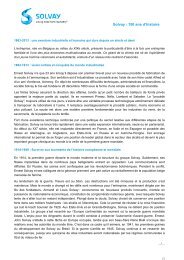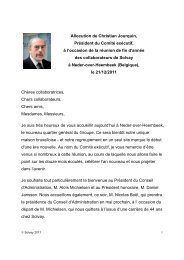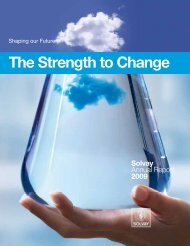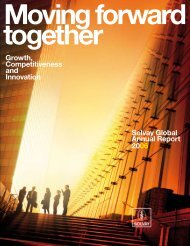solvay_live243_p02a04 somEdito
solvay_live243_p02a04 somEdito
solvay_live243_p02a04 somEdito
Create successful ePaper yourself
Turn your PDF publications into a flip-book with our unique Google optimized e-Paper software.
ations<br />
without distinction, whatever the country, wherever in the world.<br />
Another delicate issue it has faced head-on is the carbon gas emissions<br />
from heating limestone kilns with fossil fuels to produce<br />
cement. Here too Lafarge has taken a proactive stance. In 2000,<br />
working in partnership with WWF, it made a worldwide commitment<br />
to reduce emissions by 20% per tonne of cement between<br />
now and 2010 (2) , with Price Waterhouse called in to provide objective<br />
audits. Getting this right is very pertinent to its Lafarge’s activity.<br />
Indeed, a large part of its research budget is devoted to optimizing<br />
combustion processes.<br />
Innovation prize<br />
Every three years or so, Lafarge organizes its “Innovation Awards”<br />
ceremony concurrently with a meeting of 600 top managers. A village<br />
is set up for the occasions with stands for prize-winners to present their<br />
innovations. An award in the “marketing” category went to recently a<br />
transfer of practice. The group’s Indian entity had created a Customer<br />
University to invigorate its service to clients. The Kenyans became<br />
interested, went to see for themselves, and have since transposed the<br />
principle to their own country, with local adaptations. This horizontal<br />
passing of know-how within the group also falls under the heading of<br />
citizenship innovation.<br />
It also proves that, at Lafarge, innovation is not simple a matter of<br />
Awards, but is anchored in employees’ everyday reflexes. •<br />
(1) The invention transformation rate at Lafarge is a remarkably high nearly 90%.<br />
(2) The commitment covers the period 1990-2010. So far, Lafarge has achieved<br />
a reduction of 13%.<br />
Sustainable Development & citizenship<br />
© DR médiathèque Lafarge.<br />
© DR médiathèque Lafarge.<br />
Wind farm at Tetouan (Morocco).<br />
Global and local<br />
Agilia self-placing concrete<br />
being poured on site.<br />
With 2 100 operating sites in<br />
76 countries, Lafarge has annual<br />
sales of EUR 16 billion. This originally<br />
family-owned French company has<br />
gradually expanded geographically and<br />
climbed to the top of its markets by<br />
basing its activity on four naturally linked<br />
pillars: cement, granulates (stone, gravel<br />
and sand) and concrete, plasterboard<br />
and roofing materials. These are not per<br />
se highly innovative products, which<br />
explains why the R&D budget<br />
is of the order of just 1% of turnover.<br />
Even so, research is seen as highly<br />
important in terms of technological<br />
development. Research work is shared<br />
between a global centre (developing new<br />
compounds, providing ideas<br />
and information on possible fields<br />
of development) and local or regional<br />
technical centres which develop<br />
and perfect processes and provide<br />
technical assistance. This structure reflects<br />
the constraints of largely locally based<br />
operations: each quarry is different,<br />
extracted products do not travel far,<br />
and every new development has<br />
to be adapted to individual sites.<br />
Lafarge reconciles global leadership<br />
and local multiplicity by prioritizing<br />
employee motivation. Nearly<br />
50% of eligible employees hold shares<br />
in the company, producing a sense<br />
of involvement and loyalty.<br />
This is accompanied by a clearly affirmed<br />
policy of giving sites the greatest possible<br />
autonomy: a logical approach, given<br />
the high degree of local specificity<br />
in the group’s activities.<br />
J U L Y 2 0 0 6<br />
© DR médiathèque Lafarge.<br />
61


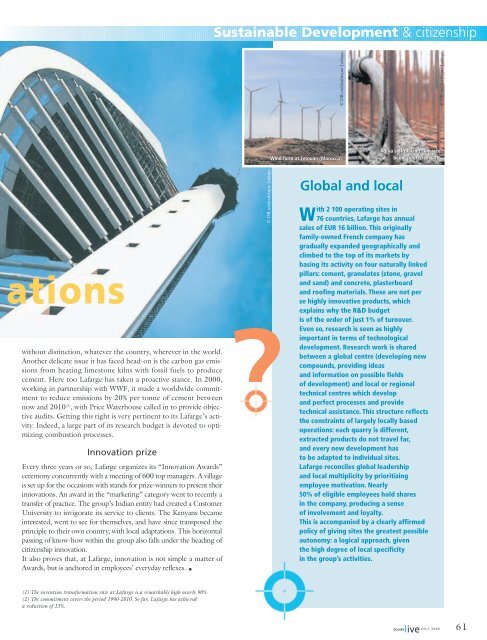
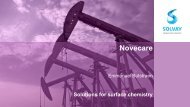
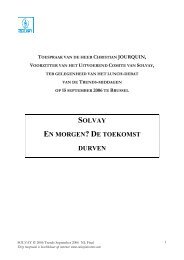
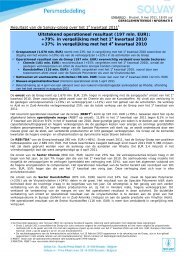

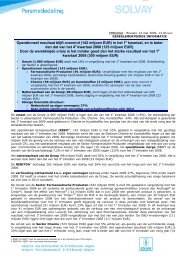
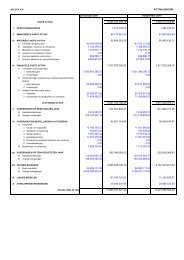

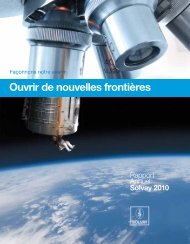
![PROC.1 [LETTRE] - Solvay](https://img.yumpu.com/16585746/1/184x260/proc1-lettre-solvay.jpg?quality=85)
